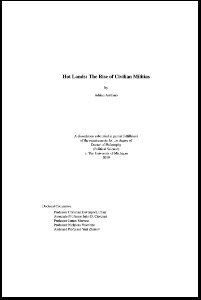Hot Lands: The Rise of Civilian Militias
By Adrian Arellano.
Why do civilians form militias? Militias emerge not when there is a lack of state security but instead when competing violence specialists behave as predatory actors. I argue that varying time horizons create the conditions for militias. I examine political reforms that have heterogeneous effects, lowering horizons for specialists and raising them for civilians. A high discount rate pushes violence specialists towards destructive violence. Having two options of violence, productive and destructive violence, specialists weigh the cost and benefits of each. The cost of productive violence is incurred up front while the cost of destructive violence occurs later, leading specialists to opt for destruction when they are experiencing a falling discount factor. However, discounting the future is self-defeating as it sets the conditions for militias. Some civilians will flee while others collaborate, but those with low discount factors will form protective militias. For civilian militias, political reforms lowers their discount rate and increases the extent to which they value the future relative to the present. Civilian militias with a low discount rate will have an interest in securing their future with arms. With the help of subnational and archival research, I show that militia onset is more likely in response to predatory actors. I test the theory using two case studies: the autodefensas in Mexico and the Deacons for Defense and Justice in the United States.
Ann Arbor: University of Michigan, 2019. 216p.


